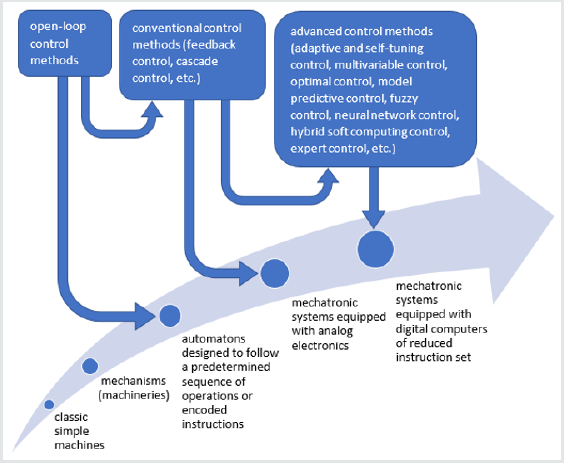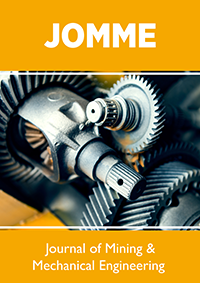
Lupine Publishers Group
Lupine Publishers
Menu
ISSN: 2690-5779
Short Communication(ISSN: 2690-5779) 
Potential Opportunities for Development of Mechanical Engineering with The Context of Historical Evolution of This Engineering Branch Volume 1 - Issue 3
Jacek Jackiewicz*
- Faculty of Mechatronics, Kazimierz Wielki University in Bydgoszcz, Poland
Received: September 06, 2020 Published: September 22, 2020
Corresponding author: Jacek Jackiewicz, faculty of Mechatronics, Kazimierz Wielki University in Bydgoszcz, Poland
DOI: 10.32474/JOMME.2020.01.000111
Short Communication
Mechanical engineering is not only one of the oldest engineering disciplines but also the broadest one, i.e., with the wide-scope as well as a large number of its branches. This engineering discipline requires a clear understanding of the principles of engineering physics, engineering mathematics, and materials science to design, analyze, manufacture, and maintain mechanical systems such as mechanisms, devices, and machines.
With a view to machines’ development, the progress of mechanical engineering advancement is often directly related to the course of civilization history. Therefore, it can be studied from many perspectives. Our attention often directs to significant particular forms or stages of civilization, which arisen throughout human history. One cannot forget about ancient cultures, both Greco-Roman (in Europe) and Chinese (in Asia), which adopted to a great extent and, then, developed often anonymous technical achievements of the first civilizations of the prehistoric period [1].
The illustrious ancient achievements had been followed by the technical culture of Islam, which not only systematized them but also improved a bit afterward. In the late Middle Ages, these achievements spurred European societies to search for new mechanical devices and, thus, the foundations were laid for the subsequent Renaissance. During the Renaissance and also after it, there was an excellent development of creative and innovative engineering thinking enshrined in treaties on machines, especially in the anthology of Italian, French as well as German technical literature. The Industrial Revolution was the culmination of all previous technological advances and which manifested itself by the transition of production processes from old manual methods to new ones supported by machines.
Mechanical engineering may be treated as a precursor to many branches of engineering, including mechatronics that is an interdisciplinary branch of mechanical engineering and electronic engineering at least, to create controlled hybrid systems, thanks to which machines can be easily automated. Besides, the use of microprocessor-based digital embedded controllers, together with a wide selection of control software algorithms dedicated to these programmable microcontrollers, enables us to build specific pieces of automation equipment based on electric motors, servo-mechanisms, and other electrical systems. Mechatronic structures are the result of the evolution of mechanical objects, bearing in mind the development history of mechanical engineering. According to the conceptual block diagram shown in Fig. 1, the application of digital technologies in mechatronic systems has provided a very different approach to automatic control [2, 3]. Thanks to the use of modern digital computers, more and more often, in the case of advanced control methods, purely mathematic models of systems’ behavior and controllers’ algorithms are abandoned in favor of sophisticated artificial intelligence (AI) techniques with the help of which control systems can learn about their environment and properly modify their behavior in conjunction with control based on knowledge to ensure their optimal performance. For this to be possible, advanced control systems must have sufficient computational capacity to create not only representative mathematical models of the controlled systems but also to modify their own adaptive control actions [4].
Derived from Babbage and Lovelace’s analytical engine digital computers with silicon chips of advanced mechatronic systems are now an inspiration to build biological computers [5] for massive computing tasks. In these machines, each processor consists of
a single biological macromolecule. By employing a significantly
large number of such macromolecules in parallel systems, solving
computational problems will be run more quickly than using
the contemporary fastest conventional supercomputers. The
application of biological computers may also be relevant from
another point of view. Namely, advances in the construction of
intelligent materials can cause the stage for the disappearance of
physical segregation between sensors, actuators, and controllers in
micro-electromechanical systems (MEMS). Moreover, note that this
is beneficial because intelligent materials used in MEMS devices
convert electrical or chemical energy directly to mechanical energy
through adequate responses of such kind of materials.
As a result of the comparison of the crucial turning points in
human history with the dynamics of machines’ development, parallel
evolutionary processes can be perceived, which are reflected in the
periods of both political and economic hegemonies of the most
technologically advanced factual civilizations. Nevertheless, the
history of mankind tells us also that some policymakers supported
successfully uncivilized methods of domination exemplified by the
Opium Wars, which were waged between representatives of the
China Qing dynasty and the Kingdom of Great Britain supported by
other European countries. In the 18th and 19th centuries, there was a
strong request for Chinese luxury goods as tea, silks, and porcelain
pottery, for which Europeans had to pay with gold or silver or
automaton clocks and pocket watches as the Qing emperors
developed an interest in these mechanical curiosities. However, the
offer of the European market at that time was insufficient to reduce
the deepening trade imbalance of European countries with China.
Therefore, the Kingdom of Great Britain, mainly, started exporting
opium grown in India and sold it to China.
However, it is reassuring that new scientific achievements make
it possible today to do what just yesterday seemed impossible. It
is comforting that even if these are military achievements, some
of them can be utilized for the benefit of humanity. For example,
instead of precise bombing by means of homing missiles with grid
fins [6], Elon Musk from SpaceX used such type of missile guidance
system to partially reusable launch systems Falcon 9 of which the
first stage having the ability to re-enter the atmosphere and landing
back vertically after separating from the second stage.
Conclusion and future directions
Just a few years ago, it seemed as though it would be many
more years for AI developed enough to threaten human creativity.
However, we are moving towards a situation where artificial
intelligence in particular areas of application will start to match
human intelligence or even become much smarter than humans.
This intelligence is especially useful when designing flexible and
intelligent mechatronic systems with adaptive controllers that can
be reconfigured both in hardware and software to suit specific tasks.
Such control systems, with reconfigurable multiprocessors, quite
often use the field-programmable gate array (FPGA) technology
[7] introduced at the beginning of the 80s of the twentieth century.
Anyone of the FPGA integrated circuit, which contains an array of programmable logic blocks and a hierarchy of reconfigurable
interconnects, can be used to build a computer.
In modern times of the use of nanometer-scale chips, due to the
predictable and resulting from Moore’s law limitations of silicon
computing devices achieving the ultra-dense scale of integration,
people began to think about the application of molecules to solve
computational problems. Molecular logic combinational gates
can be implemented as a molecular calculator, which can perform
various arithmetic operations, specifically, addition and subtraction
[8]. Inspired by the ideas of digital electronic computing based
on Boolean functions, the DNA computing technique performs
calculations using biological molecules and can be realized
by multi-layered circuits [9]. Moreover, using ribonucleic acid
(RNA), which is a crucial molecule with long chains of nucleotides
scientists have vindicated that living cells can be induced to carry
out complex computations, which are carried out in a similar way
as by computers or controllers of tiny robots. Thus, these living
cells make ‘living computers’.
Considering that 100,000 neurons in a piece of brain matter the
size of a grain of sand, the computational capabilities of biological
computing are practically endless. It is evidenced by the statement
provided in [10], viz 100 thousand neurons enable robotics with
multiple sensory inputs. However, 1 million neurons will make
possible the creation of a computer, which can think for itself.
Besides, this technology will make it easier to create mobile
microrobots for bioengineering applications.
References
- Sanz JLM, Paz EB, Ceccarelli M, Otero JE, Morgado PL, et.al.(2009) The Evolution and Development of Mechanical Engineering Through Large Cultural Areas. In International Symposium on History of Machines and Mechanisms (pp. 69-82).
- Bennett S (1996) A brief history of automatic control. IEEE Control Systems Magazine, 16(3): 17-25.
- Kozak S (2014). State-of-the-art in control engineering. Journal of Electrical Systems and Information Technology, 1(1): 1-9.
- Bissell C (2009) A history of automatic control. In Springer handbook of automation (pp. 53-69).
- Moe-Behrens GH (2013) The biological microprocessor, or how to build a computer with biological parts. Computational and structural biotechnology journal, 7(8).
- Reynier P, Longo JM, & Schulein E (2006) Simulation of missiles with grid fins using an actuator disk. Journal of spacecraft and rockets, 43(1): 84-91.
- Kelly JS, Rao VS, Pottinger HJ, & Bowman HC (1997). Design and implementation of digital controllers for smart structures using field programmable gate arrays. Smart materials and structures, 6(5): 559.
- Erbas-Cakmak S, Kolemen S, Sedgwick AC, Gunnlaugsson T, James TD,et.al. (2018). Molecular logic gates: the past present and future. Chemical Society Reviews, 47(7): 2228-2248.
- Qiu M, Khisamutdinov E, Zhao Z, Pan C, Choi JW, et.al. (2013). RNA nanotechnology for computer design and in vivo computation. Philosophical Transactions of the Royal Society A: Mathematical, Physical and Engineering Sciences, 371(2000): 20120310.
- McShane S (2016). This Amazing Computer Chip Is Made of Live Brain Cells. https://singularityhub.com/2016/03/17/this-amazing-computer-chip-is-made-of-live-brain-cells/
- Ceylan H, Giltinan J, Kozielski K, & Sitti M (2017). Mobile microrobots for bioengineering applications. Lab on a Chip, 17(10), 1705-1724.

Top Editors
-

Mark E Smith
Bio chemistry
University of Texas Medical Branch, USA -

Lawrence A Presley
Department of Criminal Justice
Liberty University, USA -

Thomas W Miller
Department of Psychiatry
University of Kentucky, USA -

Gjumrakch Aliev
Department of Medicine
Gally International Biomedical Research & Consulting LLC, USA -

Christopher Bryant
Department of Urbanisation and Agricultural
Montreal university, USA -

Robert William Frare
Oral & Maxillofacial Pathology
New York University, USA -

Rudolph Modesto Navari
Gastroenterology and Hepatology
University of Alabama, UK -

Andrew Hague
Department of Medicine
Universities of Bradford, UK -

George Gregory Buttigieg
Maltese College of Obstetrics and Gynaecology, Europe -

Chen-Hsiung Yeh
Oncology
Circulogene Theranostics, England -
.png)
Emilio Bucio-Carrillo
Radiation Chemistry
National University of Mexico, USA -
.jpg)
Casey J Grenier
Analytical Chemistry
Wentworth Institute of Technology, USA -
Hany Atalah
Minimally Invasive Surgery
Mercer University school of Medicine, USA -

Abu-Hussein Muhamad
Pediatric Dentistry
University of Athens , Greece

The annual scholar awards from Lupine Publishers honor a selected number Read More...





